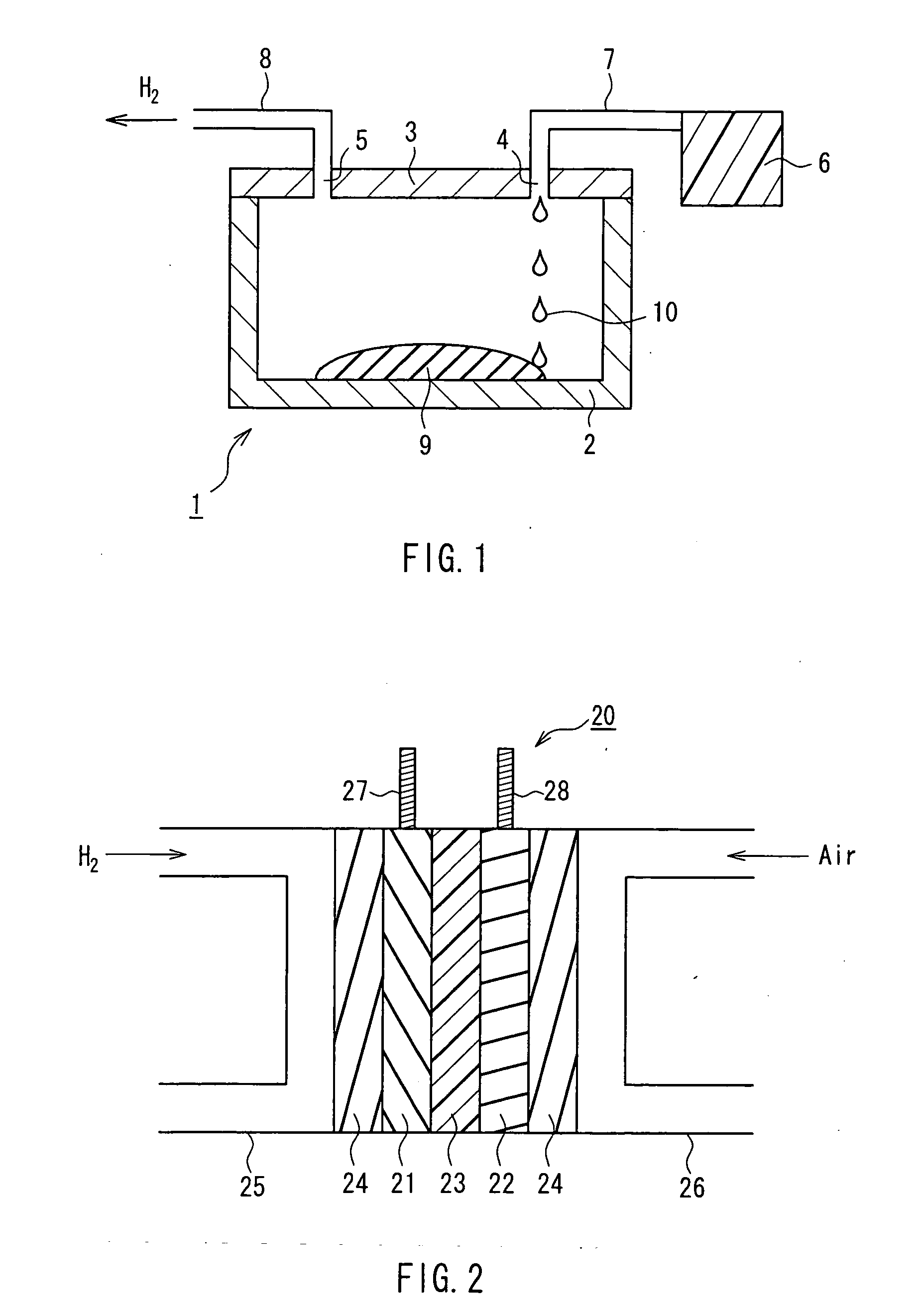Hydrogen Generating Material, Hydrogen Generator and Fuel Cell
a technology of hydrogen generator and fuel cell, which is applied in the field of hydrogen, can solve the problems of not having the expected energy density of dmfc, the reliability of lithium ion secondary batteries, and the inability of fuel cells using such tanks to be portable power sources, so as to reduce the size of fuel cells, improve electrical efficiency, and produce hydrogen easily and efficiently
- Summary
- Abstract
- Description
- Claims
- Application Information
AI Technical Summary
Benefits of technology
Problems solved by technology
Method used
Image
Examples
embodiment 1
[0021] First, an embodiment of a hydrogen generating material of the present invention will be described. The hydrogen generating material of the present invention reacts with water to produce hydrogen and includes at least one metal material selected from aluminum, magnesium, and their alloys.
[0022] When the hydrogen generating material comes into contact with water, the metal material included in the hydrogen generating material and the water can react to produce hydrogen.
[0023] The metal material generally forms a stable oxide film on the surface, and therefore the reaction with water hardly proceeds in the bulk state such as a plate or block. Even if the metal material is heated, it is unlikely to be a hydrogen gas source. However, the metal material in the form of fine particles can react with water to produce hydrogen, and the reaction accelerates particularly by heating. Thus, the metal material in the form of fine particles can be used as an excellent hydrogen source. On t...
embodiment 2
[0048] Next, an embodiment of a hydrogen generator of the present invention will be described. The hydrogen generator of the present invention includes a vessel having at least an outlet through which hydrogen flows. The hydrogen generating material of Embodiment 1 is placed in the vessel, and water is supplied to the hydrogen generating material to produce hydrogen.
[0049] By using the hydrogen generating material of Embodiment 1, hydrogen can be produced easily and efficiently at low temperatures, and the hydrogen generator can be made portable.
[0050] The hydrogen generating material reacts with water in the vessel and can produce hydrogen that serves as a fuel source of a fuel cell, which will be described later. In this case, the amount of hydrogen generated can be controlled by controlling the supply of water to the hydrogen generating material.
[0051] The material or shape of the vessel is not particularly limited, as long as the vessel can hold the hydrogen generating materi...
embodiment 3
[0054] Next, an embodiment of a fuel cell of the present invention will be described. The fuel cell of the present invention includes the hydrogen generating material of Embodiment 1 as a hydrogen fuel source. This can reduce the size of the fuel cell and improve the electrical efficiency.
[0055] Hydrogen generated by the reaction of the hydrogen generating material of Embodiment 1 includes neither CO nor CO2, which have been a problem of hydrogen produced by reforming a hydrocarbon fuel. Therefore, even if the hydrogen is applied to a polymer electrolyte fuel cell that operates at 100° C. or less, the fuel cell is not affected by poisoning due to the above gas. Moreover, since the hydrogen producing reaction involves water, the hydrogen gas generated includes a moderate amount of moisture and is very useful for the hydrogen source of the fuel cell that uses hydrogen as a fuel.
[0056] The fuel cell of the present invention may receive hydrogen from the hydrogen generator of Embodime...
PUM
| Property | Measurement | Unit |
|---|---|---|
| particle size | aaaaa | aaaaa |
| particle size | aaaaa | aaaaa |
| particle size | aaaaa | aaaaa |
Abstract
Description
Claims
Application Information
 Login to View More
Login to View More - R&D
- Intellectual Property
- Life Sciences
- Materials
- Tech Scout
- Unparalleled Data Quality
- Higher Quality Content
- 60% Fewer Hallucinations
Browse by: Latest US Patents, China's latest patents, Technical Efficacy Thesaurus, Application Domain, Technology Topic, Popular Technical Reports.
© 2025 PatSnap. All rights reserved.Legal|Privacy policy|Modern Slavery Act Transparency Statement|Sitemap|About US| Contact US: help@patsnap.com


